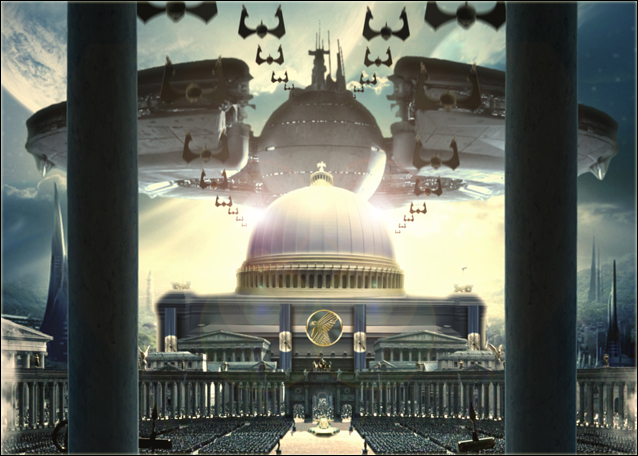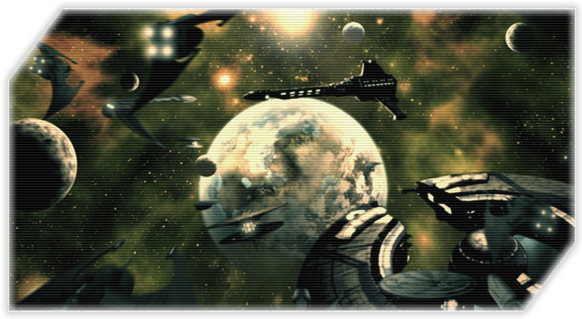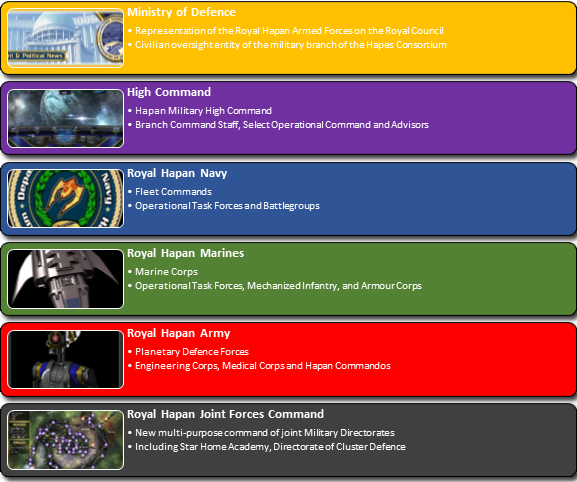Royal Hapan Armed Forces
Royal Hapan Armed Forces
Arguably one of the most powerful militaries in charted space, the staunch defenders of the Royal Hapan Armed Forces guard the borders of the ancient kingdom known as the Hapes Consortium. They protect not only the space lanes and the homes of ordinary hapans from the misery of war, but stand ready to take the fight to anyone who would challenge the Consortium's peaceful existence within the Transitory Mists.
.png)
The Royal Hapan Armed Forces symbolizes pride honour valour tradition discipline dedication

Honour of Service - Pride of the People - Glory of the Nation
A military parade takes place at the Lorell Hall, the seat of the government on Hapes Prime.
Machines of War
As the reunified Hapes Consortium emerged from the long night of the civil war, the new Hapan state sought to rebuild its fractured institutions according to a vision of the new era. The Royal Hapan Armed Forces were reformed from the remnants of the various standing fighting forces and their equipment, but with the chain of command once more answering to a single ruler on the Hapan Throne. The teachings of the brutal civil war and the victories of the Phoenix movement were still fresh in memories as the new military structure and its doctrines took shape. Many notable expatriates would also return during this time to the Hapes Cluster, bringing back with them their considerable leadership experience of both the Imperial and Alliance militaries. The Hapan state would greatly spend on equipping and modernizing the forces of the Consortium over the coming decades as the nation itself reached new heights of prosperity and industrialization, spending lavishly on research and development, with many of the designs and technologies of the military in use today developed during this period. In the years after the Black Sun Crisis, the addition of great many Miy`Til-class Starfighters, Hetrinar Assault Bombers, Nova-class Battlecruisers, as well as the Battle Dragons into active service as the military build-up continued, enhanced the strength of the Royal Hapan Navy to heights previously unimaginable, elevating the Armed Forces from a more modest national defence force into a true regional power not to be trifled with lightly.
The years that followed would see the Royal Hapan Armed Forces regularly go through smaller revisions as it sought to keep up with the times. The Hapan military doctrines would become notably adjusted, however, with foreign designs beginning to make their way into the hands of the service branches; Imperial walkers, Star Destroyers of all variants, Trade Federation droids and battleships, Mandalorian small arms, and numerous other additions to the arsenal of indigenous designs proved invaluable for the Royal Hapan Armed Forces’ ability to be able to deploy enough firepower to hold its positions in the face of any adversary.

Doctrines
Known previously for combining strategic patience with swift counter-attacks to respond to any incursions into the Hapes Cluster, the addition of such formidable foreign armaments to frontline units changed the way RHAF prepared for war. Hapan military planners had traditionally relied on the response times afforded by the short distances between systems, coupled with the relatively high hyperspeeds Nova-class Battlecruisers could achieve to deploy groups of Nova’s with fighter wings to delay and harass any hostile formations too strong to be taken head on. This was used to buy time for the fleets to muster to deploy in concert in sufficient numbers against any adversaries with a numerical or technological advantage over the hapan defenders.
The addition of heavy capital class warships into the fleets deployed to important systems, and the increasingly fortified local defences meant that often case even smaller Battle Dragon and Nova-class Battlecruiser based groups could now be jumped in immediately and be anchored onto the field by the firepower afforded by the Imperial Star Destroyers. This was calculated to greatly reduce the likelihood of needing to yield position in the face of overpowering enemy presence while waiting for the full weight of the Hapan military to manoeuvre into position, a crucial delay that could’ve forced the field commanders to choose between committing their forces too early, or risk watching as local defences get overrun and reinforcement paths cut off.
In similar tone, despite the more than satisfactory effectiveness of hapan small arms, the quality of the standing army and marine detachments continued to grow with the upgrades to personal gear and supporting elements, in particular to heavier armoured units, larger delivery systems to complement the venerable Atlas-class Troop Transport Shuttle, and to personal shielding, introduced over the years. More recently, there has been a notable increase in conscription figures for non-native races, as the Royal Hapan Army and the Royal Hapan Marines have begun to make greater use of the more diverse population living in the Cluster today, in their efforts to recruit the sentients with the best possible traits for frontline combat.
The introduction of new variants of the Miy`Til-class Starfighters and Hetrinar Assault Bombers are expected to offer better support for the movements of capital ship formations, as well as prove useful in providing better screening for forward deploying planetfall and ship boarding forces. The well-rounded nature of the Battle Dragon regardless ensures that its role as the main battleship of the Royal Hapan Navy will remain uncontested for the foreseeable future. And as local system and planetary defences continue to be reinforced with growing numbers of fighter garrisons and weapons installations in space and on the ground, aided by improvements to response times gained through advances to the streamlined joint forces command lines, first warning and communication systems, any opponent seeking to invade the Cluster is ensured to find itself facing against a well prepared defender.
Yet, there is a wide consensus among strategists that any conflict that would force its arrival upon the Consortium would be unlikely to be ended conclusively simply by repelling the enemy in the Cluster. Hence, the Royal Hapan Armed Forces must maintain its readiness to project force and sustain operations far away from the borders of the Cluster, be it in the form of small strike groups, or even entire assault fleets.
Structure
The Royal Hapan Armed Forces as the military arm of the Hapes Consortium answers to the Ministry of Defence, which represents it within the Royal Council, while the Sovereign is the Head of State and Commander-in-Chief of the Armed Forces. The different service branches and key operational units are represented on the Hapan Military High Command, through which the armed forces of the Consortium are led across the home sector and beyond.

RHAF's Four Branches
RHAF is comprised of four service branches;
The Royal Hapan Navy [RHN] is the second oldest if most senior of the four branches, home to the Consortium’s naval armada. As the vanguard of the Cluster’s defence, the Navy patrols the Cluster nebulae and its bustling space lanes, monitoring and intercepting foreign reconnaissance missions and smuggler activity alike. Well trained and armed against both pirate incursions and outright invasions alike, it responds to threats with considerable prejudice.
The Royal Hapan Army [RHA] is the oldest service branch in existence, responsible for operating the military’s planetary garrisons and defence installations, manning everything from the massive Golan II-defence platform constellations across the Hapes Cluster to maintaining standing planetary armies and training reservists. Coordinating with the detachments of the other service arms, the Royal Hapan Army is able to mobilize at short notice to meet any approaching invasion head on, with its array of entrenched troop positions, area-of-denial weapon installations, orbital defence platforms and massive orbital artillery embankments among the most important defensive elements at the High Command’s disposal.
The Royal Hapan Marines [RHMC] are the mobile mechanized infantry and armoured planetary assault forces of the Hapan military. They train in the hostile environments of exotic and beautiful planets, as well as in the vacuum of space, to stand ready to carry out boarding actions on hostile capital class warships, or to rapidly deploy and retaliate against foreign invasion forces landing on Hapan soil. At their disposal are the most advanced and heavily armed armoured brigades and mechanized infantry and droid platoons that the Consortium can muster.
The Royal Hapan Joint Forces Command [JFC] is the newest addition to the military structure to receive the designation of a stand-alone branch. In practise, it combines such elements as would’ve once functioned within the service arms’ headquarters units and as branch specific offices and departments, bringing them together as combined directorates of the Joint Forces Command, manned in collaboration with all service arms. It includes the Star Home Academy, the Directorate of Cluster Defence, as well as the Directorates of Military Reserves, Military Intelligence, and Special Forces Command.
Finally, while it has disappeared behind the veneer of civilian institutions and is no longer part of the military structure and hierarchy, the Royal Hapan Support Corps bears mentioning as having been one of the original three service arms represented on the military council, alongside the Royal Hapan Army and the Royal Hapan Navy. While its present manifestation is harder to pin down, its work remains impactful for the entire Armed Forces.